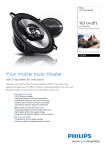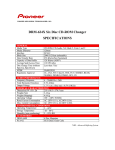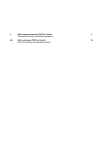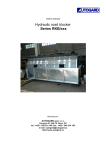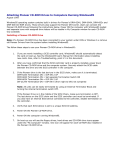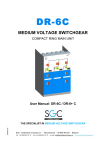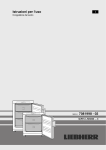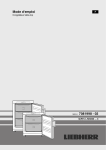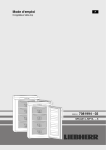Download Monitorq Industrial Torque Monitor Installation
Transcript
Monitorq Industrial Torque Monitor Installation & Operating Instructions British Autogard Ltd Siddington, Cirencester Glos., GL7 6EU, UK Tel: +44 (0)1285 640333 Fax: +44 (0)1285 659476 www.autogard.com 40611 Monitorq1 Manual Monitorq Installation & Operating Instructions -1- Contents 1 GENERAL DESCRIPTION ................................................................................................................................................... 3 1.1 2 TORQUE RING ASSEMBLY................................................................................................................................................ 4 2.1 2.2 2.3 2.4 2.5 3 GENERAL:.......................................................................................................................................................................... 6 DIMENSIONS ...................................................................................................................................................................... 6 INSTALLATION .................................................................................................................................................................... 6 BASIC WIRING.................................................................................................................................................................... 7 ANALOGUE OUTPUTS ........................................................................................................................................................ 7 TRIPS ................................................................................................................................................................................. 7 EXTERNAL RESET & START ................................................................................................................................................ 7 OTHER INPUTS................................................................................................................................................................... 8 SAFETY .............................................................................................................................................................................. 8 E520A - GETTING STARTED .............................................................................................................................................. 8 5.1 5.2 5.3 5.4 5.5 6 GENERAL ........................................................................................................................................................................... 5 DIMENSIONS ...................................................................................................................................................................... 5 E60RX SPECIFICATIONS .................................................................................................................................................... 5 INSTALLATION .................................................................................................................................................................... 5 E520A DISPLAY UNIT .......................................................................................................................................................... 6 4.1 4.2 4.3 4.4 4.5 4.6 4.7 4.8 4.9 5 GENERAL:.......................................................................................................................................................................... 4 SPECIFICATIONS ................................................................................................................................................................ 4 FITTING ............................................................................................................................................................................. 4 GUARDING......................................................................................................................................................................... 4 RESETTING ZERO ............................................................................................................................................................... 4 E60RX RECEIVER ................................................................................................................................................................. 5 3.1 3.2 3.3 3.4 4 SYSTEM DESCRIPTION: ...................................................................................................................................................... 3 PRE POWER-UP CHECKLIST ............................................................................................................................................... 8 POWER UP......................................................................................................................................................................... 8 SET-UP .............................................................................................................................................................................. 8 INSTALLER MODE .............................................................................................................................................................. 9 USER MODE .................................................................................................................................................................... 10 MAINTENANCE INSTRUCTIONS ................................................................................................................................... 11 6.1 6.2 6.3 REPLACING A FUSE. ......................................................................................................................................................... 11 BATTERY REPLACEMENT .................................................................................................................................................. 11 ZERO TORQUE SETTING ................................................................................................................................................... 12 7 MONITORQ TROUBLESHOOTING................................................................................................................................ 12 8 E70A10 CURRENT DATA MODULE................................................................................................................................ 14 8.1 8.2 8.3 9 DESCRIPTION................................................................................................................................................................... 14 CONNECTIONS ................................................................................................................................................................. 14 SPECIFICATIONS .............................................................................................................................................................. 14 E70V10 VOLTAGE DATA MODULE ............................................................................................................................... 15 9.1 9.2 9.3 10 DESCRIPTION................................................................................................................................................................... 15 CONNECTIONS ................................................................................................................................................................. 15 SPECIFICATIONS .............................................................................................................................................................. 15 E70S10 STATUS DATA MODULE................................................................................................................................ 16 10.1 10.2 10.3 DESCRIPTION................................................................................................................................................................... 16 CONNECTIONS ................................................................................................................................................................. 16 SPECIFICATIONS .............................................................................................................................................................. 16 11 APPENDIX A : E520A MENU NAVIGATION ............................................................................................................ 17 12 APPENDIX B : E520A ENTERING AND CHANGING VALUES............................................................................ 17 13 APPENDIX C: GOOD WIRING PRACTICES........................................................................................................... 18 14 APPENDIX D: E520A RELAY OPERATION DESCRIPTION: .............................................................................. 19 15 APPENDIX E: START & RESET WIRING CONNECTIONS: ............................................................................... 20 40611 Monitorq1 Manual Monitorq Installation & Operating Instructions -2- 1 1.1 General Description System Description: Autogard’s Monitorq is an electronic torque measuring system for use with rotating equipment in industrial installations. The system consists of three parts: 1) Torque ring assembly 2) Telemetry receiver and 3) Output device. As shown below. T O R Q U E R IN G W IT H IN T E G R A T E D R A D IO T R A N S M IT T E R E60R X TELEM ETRY R E C E IV E R E520A TO RQUE M O N IT O R D IS P L A Y U N IT The Torque Ring is typically of the form as shown above. The outer flange is bolted to one part of the drive train, and the inner flange to the other part. Strain gauges measure the torque being transmitted through the Torque Ring and this data is converted via the integral battery powered circuitry into a radio signal. Autogard’s Telemetry receiver (E60RX), receives the radio signal from the Torque Ring and converts it into an RS485 digital signal. The receiver is connected to one of Autogard’s Output or Display modules by a cable. The Monitorq system has a range of output or display options. The most popular is the E520A Torque Monitor with a real time display of the torque reading and on-screen configurable trip levels that can be used to control machinery, alarms, etc with the two in-built relays. In addition, the E520A has two analogue outputs of the torque data (0-10V Output, and 4-20mA Current Loop) that can be used for control purposes or data acquisition. Autogard can also offer stand-alone modules that convert the RS485 data from the E-60RX telemetry receiver into a current output (4-20mA) – the E70A module or a voltage output (010V) – the E70V Module. In addition, an E70S Status module can be used to indicate the status of the telemetry and the torque ring battery. These modules can be used when a display of the torque or user programmable trips are not required 40611 Monitorq1 Manual Monitorq Installation & Operating Instructions -3- 2 2.1 Torque Ring Assembly General: The torque ring is usually supplied as an assembly with adapters suitable for direct connection into the user’s drive train. Adapter flanges are connected to the torque ring using special fitted bolts that are factory fitted and torqued. The torque ring has no capacity to absorb misalignments in the drive train. Any misalignment should be taken out using a suitable flexible coupling. Please refer to Autogard’s full range of flexible coupling products. Special consideration should be given if the torque ring is to be fitted inside a metal housing. Close proximity of metal parts to the aerial ring may attenuate the radio signal and cause loss of telemetry. As a guide, at least 50mm radial clearance is required. There is to be no metalwork between the receiver and the torque ring as this would act as a barrier to the radio signal. 2.2 Specifications Operating temperature limits: Torque sampling rate Resolution Accuracy Radio Frequency Radiated power Battery Battery life 2.3 0° to +60°C 100Hz 10 bit (0.2% FSD – bipolar) +/- 5% Full Scale, at 20oC 27.145MHz (FM) < 1µW Maxell ER17/33(2/3A), Lithium Thionyl Chloride, 3.6V, 1700mAh (2 or 4 depending on Torque Ring Sise max) 6 Months for 2 battery Torque Rings 12 Months for 4 battery Torque Rings Fitting Using suitable equipment, support the torque ring assembly in position in the drive-train and make connections to mating parts using suitable fasteners. See datasheet for dimensions and details. It should be noted that the torque ring contains micro-electronic components and load sensing elements. Although it has been designed to withstand normal handling and operating loads, undue force should not be used when fitting. Avoid press fitting, impact loads and, under no circumstances, should heat be applied. Care should also be taken not to dislodge the plastic aerial ring from around the unit. When installing the torque ring assembly, the bolts used must not protrude through the adapter plates and make contact with the torque ring itself. This is likely to give erroneous torque readings and could cause permanent damage to the torque ring. 2.4 Guarding As with all rotating equipment, suitable guarding must be provided, in accordance with statutory requirements and all local and national codes of practice. 2.5 Resetting Zero All torque rings are adjusted to read zero torque in the free state before leaving the factory. However, small zero offsets may be evident after installation. These are often due to lockedin torque in the shafting and connections, and are normal. In general, re-setting the zero is not recommended or necessary. It is recommended that the TARE function on the E520A unit should be used instead (see Section 5.5) 40611 Monitorq1 Manual Monitorq Installation & Operating Instructions -4- 3 3.1 E60RX Receiver General The E60RX radio receiver decodes signals from the torque ring and sends the data, via a cable connection, to the output device. The receiver is housed in a standard M30 threaded body that is mounted close to the torque ring. The receiving aerial is housed in the plastic nose – this should be located such that it faces the torque ring. 3.2 Dimensions 3.3 E60RX Specifications General Specification: Supply Voltage Output (Signal) Voltage Cable Type Maximum Cable Extension Length (Shielded) Operating Temperature Range Environmental Protection Rating +12V (Supplied from E520A Unit) RS-485 3m Type 7-2-6C Shielded 6mm OD 800m max (0 to +60°C) IP65 LED Functions: LED Illuminated Red Green Yellow Meaning Power OK Radio Signal Detected Not Used Wiring: Wire Colour Red Blue Green Yellow 3.4 Function +12V DC 0V DC + Torque Signal - Torque Signal Connected to E-520A terminal 1 E-520A terminal 2 E-520A terminal 3 E-520A terminal 4 Installation The E60RX is mounted with the plastic nose facing the plastic section of the Torque Ring. Using a suitable bracket (not supplied) securely mount the E60RX adjacent to the torque ring, ensuring that it will not come into contact with any rotating parts. The distance between the end of the E60RX and the Torque Ring should be 5mm or less. 40611 Monitorq1 Manual Monitorq Installation & Operating Instructions -5- The E60RX cable should be routed to the E520A, ensuring that good practice is followed regarding the avoidance of interference from motor cables. Please refer to the notes in Appendix C – especially where variable speed drives (VSD’s) are used. The cable supplied with the E-60RX is shielded and this should be connected to an earth point on the E520A. Any extension cable should also be shielded. If required, Autogard can supply the E60RX with a 60ft cable. Make the cable connections to the E520A with reference to the details above and section 4.4. With power switched on to the E520A and with batteries fitted in the Torque Ring, the red and green LED’s on the E60RX should be illuminated. 4 4.1 E520A Display Unit General: The E520A is the control and display unit for the Monitorq system. The torque value is displayed on the E520A screen and features are included for setting trip levels to activate alarms, process control functions etc. Voltage and current loop outputs are also provided for use with external monitoring and control equipment. 4.2 Dimensions 4.3 Installation It is advisable to mount the E520A away from any Variable Speed Drives and preferably in a separate cabinet. See Appendix C. The E520A is designed for panel mounting and requires a square cut-out 91 x 91 mm (+0.5mm, -0.0mm). The power unit in the E520A is a universal, “switch-mode” type and may be connected to any single phase supply in the range 100-240V AC, 0.5A. The equipment must be installed by suitably qualified personnel in accordance with statutory regulations and all local and national codes of practice. 40611 Monitorq1 Manual Monitorq Installation & Operating Instructions -6- Insert the E520A into the panel from the front making sure that the sealing strip is in place. Fit the panel clamps (supplied) to the sides of the unit, slide back so that they locate on the plastic lugs and tighten the threaded pin to secure the unit to the panel. 4.4 Basic Wiring Removable connector strips are provided with the E520A and these accept up to 2.5mm diameter solid or stranded wire. Connect the mains supply and E60RX according to the basic wiring diagram below. Users of the old E520 should note that the mains connections have changed! 4.5 Analogue Outputs The 0-10V voltage output and the 4-20mA current loop output are for connection to external monitoring equipment, if required. The outputs are referred to 0V, but are floating from earth so they may be connected to an earthed system without forming a ground loop. In both cases, zero torque is at mid scale, i.e. at 5V and 12mA respectively. 4.6 Trips The relays have both normally open (NO) and normally closed (NC) connections. The relays change state in reaction to the trip settings. See 5.5. They stay in their normal condition on loss of power. The user should ensure that they are used safely, especially in relation to motor shutdown. Relays used for motor shutdown should always be configured to latch on trip. Nonlatching relays may typically be used to trigger an audible or visual alarm. Please see Appendix D for further information about the Relay Operation 4.7 External Reset & Start The 100-240V AC EXT RST and START inputs are wired up if remote resetting of the E520A after a trip is required, or the motor START sensing function is selected. See section 5.5 for 40611 Monitorq1 Manual Monitorq Installation & Operating Instructions -7- details of how to configure the function, and Appendix E for details of how these inputs should be wired. 4.8 Other Inputs Other inputs (RPM, AUX and 0-10V) are not used in this version of the E520A. 4.9 Safety Once installation and wiring is complete, the E520A must be enclosed so that protection against live (hazardous) parts is prevented, in accordance with statutory regulations. The monitor must be fully isolated from all electrical power sources before carrying out any installation, servicing or maintenance. 5 5.1 E520A - Getting Started Pre power-up Checklist Verify items in the following checklist before powering up the unit. Improper installation can result in equipment damage. • If motor shutdown is wired through one of the E520A’s internal relays, it should be wired to ensure safe shutdown in the event of power loss. • If any of the Analogue outputs have been wired (0-10V, 4-20mA) verify that they have been wired back to the 0V connection on the E520A to prevent ground loops. • The independent, primary disconnection device must comply with statutory wiring regulations. 5.2 Power Up After power is applied, the Autogard Logo screen is displayed on the E520A for a few seconds followed by a second screen with company and contact information. The unit then displays the normal “run-time” screen. The screen contrast can be adjusted if necessary by holding the up or down arrow key for a few seconds. As well as numerical data, the display incorporates the following status symbols: Filled Circle – bottom RH corner The unit is unable to detect a valid torque signal – e.g. no E60RX connected, torque ring not in range or no telemetry being transmitted from the torque ring. Unfilled Circle – bottom RH corner An intermittent torque signal is detected – e.g. E60RX not close enough to ring, signal from ring too weak, external interference present. Crossed Battery Symbol – bottom LH corner Battery charge in the torque ring is low. This may also be accompanied by the “Unfilled Circle” symbol. This indicates that the batteries need to be replaced. In normal operation these areas remain blank. 5.3 Set-up The various E520A set-up options are accessed by holding down the front panel LEFT ARROW key for a few seconds. This displays the initial SETUP menu. To return to normal running, use the Up and Down arrow keys to select EXIT from the menu, then press the OK key. 40611 Monitorq1 Manual Monitorq Installation & Operating Instructions -8- Two modes, INSTALL and USER, may be entered from the initial SETUP menu. The general philosophy behind these two modes is that INSTALL is intended for initial set-up (usually on commissioning) and USER is for customer settings. The HELP item on the menu gives Autogard contact details that may be used if further assistance is required. To exit HELP, press OK. Each mode enables various parameters to be set up, via a menu system. The UP and DOWN arrows on the front panel move a cursor (>) through the menu. To select or change the status of an item press OK. To adjust a value, use the UP and DOWN arrows. The LEFT and RIGHT arrow keys are used to select the digit to be changed. To confirm an entry press OK. When the value is set, press OK again. Further details of menu navigation are given in Appendix A, while Appendix B details how the various levels, delays and values are set up. 5.4 Installer Mode SETUP > INSTALL USER HELP EXIT INSTALL > TORQUE OUTPUTS EXIT TORQUE > CONFIG IMPERIAL RING TYPE EXIT OUTPUTS > INST EXIT CONFIG >Nm F/SCALE EXIT OK AV kNm OK SET VALUE IMPERIAL > in lbs EXIT OK ft lbs RING TYPE > 10 BIT EXIT OK 8 BIT The following notes describe the functions available using the INSTALL menu, as shown above. Full-scale Torque The E520A must be set up so that the value for maximum torque matches the full scale calibration marked on the torque ring. (This will have been done at the factory.) Select CONFIG. The scale is set in Nm or kNm. Select F/SCALE and, if not pre-set to the correct torque, adjust to the required value. Units The choice of metric or imperial units is selected in the USER/DISPLAY menu. The units of display (Nm. kNm, in-lbs or ft-lbs) are determined by the settings in this menu. If METRIC is selected in USER, the units set under INSTALL/CONFIG are used. If IMPERIAL is selected under USER, the units set under IMPERIAL in the INSTALL menu are used. Ring Type For all Monitorq systems sold after mid 2001, the Ring Type setting should be set to 10-BIT. Users with Strain Rings made before this date may have to set this to the 8-BIT setting. Consult Autogard if in doubt. 40611 Monitorq1 Manual Monitorq Installation & Operating Instructions -9- Outputs 5.5 The unit is provided with two analogue outputs: 0-10V or 4-20mA. The signals may be set to be either averaged (AV) or instantaneous (INST) If AV is selected, the output is integrated with a 0.25 second time constant. User Mode SETUP > INSTALL USER HELP EXIT USER > DISPLAY TRIPS START UTILS EXIT DISPLAY > METRIC POL ON EXIT TRIPS >TRIP 1 TRIP 2 TRIP 3 T FLT OFF RELAYS EXIT START >OFF DELAY EXIT UTILS > VERSION AVERAGE TARE EXIT OK OK OK IMPERIAL POL INV T FLT ON OK POL OFF TRIP 1 > OFF LEVEL DELAY RELAY 1 LATCH OFF EXIT OK RELAYS > RL1 NORM RL2 NORM EXIT OK ON SET VALUE O/LOAD U/LOAD SET VALUE SET VALUE OK RELAY 2 OK LATCH ON OK RL1 INV OK RL2 INV VERSION NUMBER OK TARE > REAL EXIT PEAK OK NULL The following notes describe the functions available in the USER menu structure, as shown above. Display In the DISPLAY option, the user can swap between METRIC and IMPERIAL units of torque. The indicated polarity of the torque can also be changed: POL ON turns on the + or – symbol. POL OFF turns the symbols off. POL INV reverses the displayed polarity Trips Three independent trips are available, each of which is set up in the same way, and operates either of two relays, in addition a red LED on the E520A front panel will also be lit. The fourth trip, T FLT (Trip-Fault), if set to ON, will switch Relay 2 (without latching) when bad telemetry between the Strain Ring and the receiver occurs, or when the Strain Ring batteries are running low. Each of the 3 independent trips may be set OFF, or to respond to overload (O/LOAD) or underload (U/LOAD) conditions. The LEVEL (the value of the displayed parameter) at which the trip occurs is selectable, as well as the DELAY following the trip level being passed. Each trip may operate either RELAY 1 or RELAY 2, and each trip may be latched if required. 40611 Monitorq1 Manual Monitorq Installation & Operating Instructions - 10 - WARNING: If using the trips to control machinery it should be ensured that the relays are wired, and the software configured, in such a way that if bad telemetry or a power failure occurs, the system will behave in a safe manner. Please see Appendix D for further information about the Relay configuration. Start When a motor driving a system is switched on, there is likely to be some unusual torque peaks, etc whilst the system gets up to running speed. The START function is included in the E520A to prevent these peaks activating the TRIPS. If the START function is ON, when an AC Mains input is sensed on Pin 15 of the 15 Pin Connector, the START function is activated and the TRIPS will ignore any torque value sensed until the time period set in DELAY has elapsed. The LED labelled “R” on the front panel of the E-520A will be illuminated whilst there is an AC input on pin 15. Utilities If PEAK is selected, then the E-520A displays the largest torque value seen since the unit was turned on, Reset, or the Start function used. AVERAGE just displays the normal torque output. The UTILS menu enables the installed program VERSION to be displayed. The TARE facility enables a system torque offset to be nulled. With the system in its nominally zero-torque state, select TARE and set the option to NULL. The E520A will then subtract the offset value and display the net torque – this also nulls the analogue outputs. Note: the maximum offset that can be nulled in this way is 10% of full scale. In normal operation, the TARE setting should be REAL – i.e., the absolute value of torque transmitted by the torque ring is displayed. 6 6.1 Maintenance Instructions Replacing a fuse. The E520A monitor must be fully isolated from all electrical power sources before carrying out any installation, servicing or maintenance. Remove the E520A rear panel and withdraw the power supply board (upper PCB). The fuse is located in a holder on the left hand side when looking down on the board from the back. (See section 4.2). Remove the fuse and replace with a ‘slow blow’ type T 315mA rating. 6.2 Battery replacement When the “battery low” symbol appears on the E520A screen, all batteries should be replaced at the same time. The replacement sequence is not important. The batteries are special high capacity lithium type, 3.7V, size 2/3A, 1700mAh (4 batteries used for most units, 2 for smaller torque rings). The approved brand is Maxell ER17/33. These may be obtained commercially or be supplied by Autogard. Access to the batteries is via radial ports (max 4) around the periphery of the plastic aerial ring. The procedure is: • Remove one of the battery caps (stainless steel slotted fitting in each port) by unscrewing (anticlockwise) with a broad bladed tool. NB! Some models have locking grub screws fitted through the face of the Monitorq ring. Please remove these first. • The battery, which is spring loaded, will project out of its holder. It may be necessary to use thin-nosed pliers to grip the battery button to remove it. • Fit a new battery with the +ve end (button) facing radially outwards. • Refit the battery cap. Do not over-tighten. Excessive force can damage the battery holder. • Repeat the procedure for the other batteries. 40611 Monitorq1 Manual Monitorq Installation & Operating Instructions - 11 - WARNING! 6.3 Do not puncture, crush, or dispose of Lithium batteries in fire. Observe local regulations for disposal. Zero Torque Setting If there is a zero torque offset present once the strain ring has been built into the system, this can either be removed using the TARE function described in section 5.5, or by actually adjusting the torque ring output itself. It should be noted that the Torque ring is calibrated at the factory and changing the zero torque setting will effect the calibration. The zero adjustment screw is accessible via a radial hole in the plastic aerial ring. Remove the labelled screw plug (one of a pair of holes) and, using a long screwdriver, locate the small potentiometer top located at the bottom of the hole. Rotate as required until zero is obtained on the E520A display. Note: the other screw which is marked with tamperproof paint, is for calibration setting and must not be adjusted. If in doubt, consult Autogard. 7 Monitorq Troubleshooting FAULT POSSIBLE CAUSE ACTION 7.1 Display does not illuminate Power disconnected Check mains lead attachment Fuse blown in E520A Check cause of overload and replace fuse. Supply voltage outside required range (100-240V AC) Contrast needs adjusting Check supply voltage and correct, if necessary. In normal operating mode, use up and down arrows to adjust. Normal RING TYPE is 10 BIT. If the torque ring is old, (mid 2001 and earlier), the 8 BIT setting may have to be used Consult Autogard if in doubt. 7.2 Display difficult to read or appears blank 7.3 Open circle in bottom left corner of screen Incorrect “RING TYPE” selected on E520A Radio signal from torque ring is weak. Adjust E60RX position to be as close to ring as possible. Check that nothing is screening the receiver from the aerial. Move ring away from heavy metalwork. Interference present. 7.4 Solid circle in bottom left hand corner of screen. No green LED on E60RX, but red LED ON. 40611 Monitorq1 Manual No signal received from the torque ring. Check for external RF signals. Check position of E60RX. Re-position if necessary. Check battery condition. (3.7V). Replace all batteries if voltage is lower than 3.5 Monitorq Installation & Operating Instructions - 12 - Volts. 7.5 Solid circle in bottom left hand corner of screen. No green LED or red LED on E60RX. Power supply failure in E520A 7.6 E-520A screen “frozen” 7.7 Torque readings appear incorrect Processor “hang-up” Data is corrupt due to weak radio. 40611 Monitorq1 Manual E60RX failure Check for damage to the aerial ring. Check power supply. Should be 12V on terminals 1 and 2 on 15 pin connector Fit replacement E60RX Power off, then power on. See 7.3 above. Incorrect full scale torque set on E520A Set full scale to match torque ring per the rating label. Torque too low in relation to full scale. Check torque ring selection. Consult Autogard re recalibration. Large zero offset present Check reading in expected “zero” torque state. Adjust offset as necessary. Fixings interfering with torque ring Check mounting design and ensure no customer fixings touching torque ring Monitorq Installation & Operating Instructions - 13 - 8 8.1 E70A10 Current Data Module Description The E70A10 is a DIN rail mounting module which converts the digital torque signals from the E60RX into a 4-20mA analog signal. The output changes pro rata with the applied torque. A 12mA output equals zero torque, 20mA output equals maximum positive torque and 4mA equals maximum negative torque. LED indicators are used to show the status of the received torque data, the status of the torque transducers battery and the status of the E70A’s internal power supply. The E70A10 module requires a +24 VDC supply, rated at 100mA. This is sufficient to power itself and the E60RX. 8.2 Connections Terminal 1 2 3 4 5 6 7 8 8.3 Function E70A10 Gnd E70A10 Power - (4-20 mA) +(4-20 mA) E60RX Power E60RX Gnd E60RX Data + E60RX Data - Connects To 24 VDC Supply 24 VDC Supply Measuring Device Measuring Device E60RX Red Wire E60RX Blue Wire E60RX Green Wire E60RX Yellow Wire Specifications Electrical Supply Voltage Supply Current Analog Output Output Resolution Frequency Response Input Signal LEDs Mechanical Size Location Temperature Environment 40611 Monitorq1 Manual +24V 100mA (Max) 4-20mA 0.4% of Full Scale 30 Hz RS-485 (From E60RX) Data OK Batt OK Power OK 75(h) x 20(w) x 79.5(d) mm DIN Rail Mounting -40oC to +50oC Monitorq Installation & Operating Instructions - 14 - 9 9.1 E70V10 Voltage Data Module Description The E70V10 is a DIN rail mounting module which converts the digital torque signals from the E60RX to a 0 to +10 volt analogue signal. The output changes pro rata with the applied torque. A 5v output equals zero torque, +10V output equals maximum positive torque and 0V equals maximum negative torque. LED indicators are used to show the status of the received torque data, the status of the torque transducers battery and the status of the E70V’s internal power supply. The E70V10 module requires a +24 VDC supply, rated at 100mA. This is sufficient to power itself and the E60RX. 9.2 Connections Terminal 1 2 3 4 5 6 7 8 9.3 Function E70V10 Gnd E70V10 Power 0-10V Output Analog Ground E60RX Power E60RX Gnd E60RX Data + E60RX Data - Connects To 24 VDC Supply 24 VDC Supply Measuring Device Measuring Device E60RX Red Wire E60RX Blue Wire E60RX Green Wire E60RX Yellow Wire Specifications Electrical Supply Voltage Supply Current Analogue Output Output Resolution Frequency Response Input Signal LEDs Mechanical Size Location Temperature Environment 40611 Monitorq1 Manual +24V 100mA (Max) 0-10 VDC 0.4% of Full Scale 30 Hz RS-485 (From E60RX) Data OK Batt OK Power OK 75(h) x 20(w) x 79.5(d) mm DIN Rail Mounting -40oC to +50oC Monitorq Installation & Operating Instructions - 15 - 10 E70S10 Status Data Module 10.1 Description The E70S10 is a DIN rail mounting module which can only be used with other Autogard E70 modules. It provided diagnostic signalling that may be used by a PLC to monitor the operating status of a Torque Ring and E60RX installation. LED indicators are used to show the status of the received torque data, the status of the torque transducers battery and the status of the E70S10’s internal power supply. Relays are activated along with these status indicators. The E70S10 module requires a +24VDC supply, rated at 100mA. (Note that the E70S10 does not provide power to the E60RX) 10.2 Connections Terminal 1 2 3 4 5 6 Function Power Fail Power Fail E70V10 Gnd E70V10 Power Invalid Data Invalid Data Connects To Relay 3 Relay 3 24 VDC Supply 24 VDC Supply Relay 2 Relay 2 11 12 13 14 Low Battery Low Battery E60RX Data+ E60RX Data- Relay 1 Relay 1 E60RX Green Wire E60RX Yellow Wire 10.3 Specifications Electrical Supply Voltage Supply Current Input Signal LEDs Relays Mechanical Environment 40611 Monitorq1 Manual Relays Contacts Size Location Temperature +24V 100mA (from E-60RX) RS-485 (From E60RX) Data OK Batt OK Power OK Relay 1 (Low Battery) Relay 2 (Invalid data) Relay 3 (Power Fail) All 3 Relays are held normally closed 0.5A @ 110 VAC max 75(h) x 30(w) x 70.5(d) mm DIN Rail Mounting -40oC to +50oC Monitorq Installation & Operating Instructions - 16 - 11 APPENDIX A : E520A Menu Navigation Menus are navigated by way of the '>' cursor. The cursor is moved by selection of UP ARROW or DOWN ARROW. A menu 'wraps around' from both its top and bottom items when either UP ARROW is selected with the cursor opposite the topmost item, or when DOWN ARROW is selected at the lowest item. A menu item is selected by operation of the OK key. Exit from a menu is affected by operation of the OK key when the cursor is opposite 'EXIT'. When returning to a menu following the selection of an item, the cursor always positions itself next to the topmost item, indicating the item it has returned from with a “*”. 12 APPENDIX B : E520A Entering and Changing Values Entered values have four digits : 'leading zeroes' are acceptable. Values entered may have no decimal point, a fixed decimal point position, or a selectable decimal point position. On entry into a 'value entry' box, the left-most digit flashes, indicating that its value may be changed if desired. The value of a digit may be increased by use of the UP ARROW key, or decreased using the DOWN ARROW key. 'Wraparound' occurs when incrementing from 9 (to 0), and when decreasing from 0 (to 9). A new digit may be selected by use of either the RIGHT ARROW key or the LEFT ARROW key. If the decimal point position is not selectable, operation of the RIGHT ARROW from the right-most digit causes selection of the left-most digit. If the decimal point position is not selectable, operation of the LEFT ARROW from the left-most digit causes selection of the right-most digit. If the decimal point position is selectable, operation of the RIGHT ARROW key from the right-most digit results in the left-most decimal point flashing. If there was a decimal point in that position to start with, then it flashes. If there was no decimal point in that position, then a '*' symbol flashes. A new decimal point position may be selected by use of the RIGHT ARROW key, while operation of the LEFT ARROW key returns to the right-most digit. If the decimal point position is selectable, operation of the LEFT ARROW key from the left-most digit results in the right-most decimal point flashing. If there was a decimal point in that position to start with, then it flashes. If there was no decimal point in that position, then a '*' symbol flashes. A new decimal point position may be selected by use of the LEFT ARROW key, while operation of the RIGHT ARROW key returns to the left-most digit. A decimal point may be fixed at the current position by operation of either the UP ARROW key or the DOWN ARROW key, when the flashing '*' symbol in the selected position becomes a flashing decimal point. Any existing decimal point in another position is erased when a new position is selected. If the decimal point position is selectable, operation of the LEFT ARROW key from the left-most digit results in the right-most decimal point flashing. If there was a decimal point in that position to start with, then it flashes. If there was no decimal point in that position, then a '*' symbol flashes. A new decimal point position may be selected by use of the LEFT ARROW key, while operation of the RIGHT ARROW key returns to the left-most digit. A decimal point may be fixed at the current position by operation of either the UP ARROW key or the DOWN ARROW key, when the flashing '*' symbol in the selected position becomes a flashing decimal point. Any existing decimal point in another position is erased when a new position is selected. 40611 Monitorq1 Manual Monitorq Installation & Operating Instructions - 17 - 13 APPENDIX C: Good Wiring Practices Background These notes cover “good installation practice” and apply especially for data systems installed in the vicinity of electronic variable speed drives. These are often referred to as VSD’s or VFD’s (variable frequency drives). Technical Information VSD’s work by generating voltage and current signals that are fed directly to the motor. These signals are generated within the VSD, giving full control over their amplitude, frequency and phase relationship. There are several methods of generating the signals, all of them employing some form of square wave modulation technique to approximate a sine wave. As a consequence of this, unwanted high frequency harmonics are generated which can interfere with other equipment. In the case of the Monitorq system, the most likely effect is to corrupt the digital torque signal. Mains Cables Most VSD manufacturers recommend the use of shielded cables for connection of the VSD to the mains service supply. This would normally be a 4-core (3 phases and earth) cable and should be connected in accordance with the VSD manufacturer’s instructions. Since the E520A derives its power from the mains service supply, it is important that this supply is kept as “clean” as possible. It may be necessary to add filters on to the mains input to the VSD to prevent the “noise” it generates being superimposed back onto the mains supply and hence on to the E-520A. Motor Cables Most VSD manufacturers also recommend the use of shielded cables for connection of the VSD to the motor. Again, this would normally be a 4-core (3 phases and earth) cable and should be connected in accordance with the VSD manufacturer’s instructions. It is usual to keep these wiring runs as short as possible to minimise the risk of radiated noise. Earth Connections Most VSD’s have an earth terminal which should be connected to an earth point provided for the purpose, using heavy duty cable and the shortest possible route. This ensures a good electrical path for any noise to pass to earth. It is the responsibility of the user to ensure that earthing conforms to national and local codes of practice. Control and Signal Cables These and other signal or control cables should be wired away from mains and motor wires, since they are likely to pick up the modulated signals going to the motor. It is again recommended that shielded cable is used and that the shield is connected to a suitable earth point. If control or signal cables have to run parallel to mains or motor cables, they should be separated by at least 1 foot, adding another 1 foot for every additional 30 feet of parallel run. If control or signal cables cross mains or motor cables, try to arrange them so that they cross at right angles. Positioning of the E520A It is not advisable to mount the E520A in the same cabinet as a VSD. In extreme cases, it would be possible for the VSD to radiate interference directly into the E520A (known as airborne interference), and consequently corrupt incoming data from the E60RX. 40611 Monitorq1 Manual Monitorq Installation & Operating Instructions - 18 - 14 APPENDIX D: E520A Relay Operation Description: Definition of Terms: Normally Open (NO) Normally Closed (NC) Single pole double throw Relay contact is open while relay is de-energised. Relay contact is closed while relay is de-energised. Relay that has one common, one normally open and one normally closed contact. Relay is energised in tripped state. Relay is de-energised in tripped state. Plant will trip on loss of power to the E520a, inverted configuration must be used to achieve this. "Normal" configuration “Inverted" configuration Fail safe T FLT ON Relay 2 will assume its tripped state if no telemetry or low battery is detected (for fail safe operation, relay 2 must be configured as inverted). Relay remains in tripped state until trip conditions are cleared. Relay remains in tripped state until trip conditions are cleared and reset pushbutton or external reset is operated. If more than one trip is mapped to a relay, the relay will assume its tripped state if any mapped trip condition is detected. Latch off Latch on Relay "mapping" RELAY 2 CONFIGURED AS "NORMAL" SHOWN IN NON-TRIPPED CONDITION (RELAY DE-ENERGISED) SYSTEM IS NOT FAIL SAFE L N E-520A RL2 RL2 RL2 RL1 RL1 RL1 NO COM NC NO COM NC RELAY 2 CONFIGURED AS "INVERTED" SHOWN IN NON-TRIPPED CONDITION (RELAY ENERGISED) SYSTEM IS FAIL SAFE L N E-520A RL2 RL2 RL2 RL1 RL1 RL1 40611 Monitorq1 Manual NO COM NC NO COM NC Monitorq Installation & Operating Instructions - 19 - 15 APPENDIX E: START & RESET wiring connections: 110-240 VAC LIVE NEUTRAL RESET push button switch MOTOR CONTACTOR M Note: Push button switch needs to be held down for 2-3 seconds to activate the RESET function. Addresses of spare parts stockists and service facilities British Autogard Ltd Siddington, Cirencester Glos, GL7 6EU England American Autogard Corporation 5173 26th Avenue Rockford, IL 61109 U.S.A. Tel: +44 (0)1285 640333 Fax: +44 (0) 1285 659476 Email: [email protected] Tel: +1 815 633 1441 Fax: +1 815 633 8488 Email: [email protected] Autogard Kupplungen GmbH Trifte 72 32657 Lemgo Germany Autogard Italia S.r.l Via Udine 3, 20063 Cernusco sul Naviglio, Milano Italy Tel: +49 (0)5261 921258/9 Fax: +49 (0)5261 921260 Email: [email protected] Tel: +39 (0)291 700471 Fax: +39 (0)291 700472 Email: [email protected] Autogard Asia-Pacific Pty Ltd Unit 17, 56 Keys Road Cheltenham, Victoria 3192 Australia Autogard Japan Ltd 15-16, 2- Chome, Takanawa Minato-Ku, Tokyo 108 Japan Tel: +61 (0) 39532 0901 Fax: +61 (0) 39532 1032 Email: [email protected] Tel: +81 3 34499621 Fax: +81 3 54497491 Email: [email protected] 40611 Monitorq1 Manual Monitorq Installation & Operating Instructions - 20 -




















